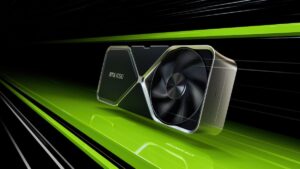
Now that NVIDIA’s GeForce RTX 40 Series graphics card and Ada Lovelace architecture are out in the open, the GPU brand has officially posted the full specifications for the GeForce RTX 4090 and two RTX 4080 graphics cards. In addition, NVIDIA gave participants a better look at the series’ Founders Edition PCB during its Editor’s Day.
We’ll start with the design of the PCB and more specifically, the compact PCB being used in the RTX 4090 Founders Edition (FE). As you can see, it looks almost identical to the PCB of its predecessor, the RTX 3090 Ti. But of course, that is at a glance. Upon closer inspection, the one feature that is missing from the RTX 4090’s PCB is the NVLink interface at the top. Let’s face it: multi-GPU setups and configurations, while an entirely feasible concept for high-end PC years ago, have fallen out of favour with both consumers and GPU brands.

While some may attribute this decline to the gradually rising cost of the graphics card, another reason behind NVIDIA’s decision to ditch the feature is also because the performance-per-watt of a single graphics card has increased exponentially, generation on generation. The RTX 4090 FE, then, is no exception to the rule. Moving on, the card also sports a new PCIe Gen5 Power connector, as well as a new 23-phase Power Supply, complete with rearchitected phases and better transient voltage management. Also, this card, along with the two RTX 4080 SKUs, are equipped with two AV1 encoders.
But let’s move on to the full specifications of the RTX 40 Series card. As officially mentioned, Lovelace is currently divided into three GPU models: AD102, AD103, and AD104. The RTX 4090 is the current king of the hill, housing the AD102 GPU, along with 24GB GDDR6X graphics memory, 16384 CUDA cores, and a 384-bit memory bus. Additional specs include 128SM processors, 512 4th generation Tensor Cores, and 128 3rd generation ray-tracing (RT) cores. For that, the GPU’s base and boost clock is rated at 2.23GHz and 2.52 GHz, respectively. Oh, it also has a memory bandwidth of 1TB/s and TDP of 450W.

Let’s move on to the RTX 4080 series and start with the base model: the one with 12GB. If you’ve been reading the discussions online, you’ll know that there’s divided opinion on the SKU’s existence, as well as whether or not NVIDIA initially wanted to market this card as the RTX 4070. In any case, and as its namesake suggests, this variant of the RTX 4080 comes with 12GB GDDR6X graphics memory running on a 192-bit memory bus, 60SM processors, 240 Tensor Cores, and 60 RTX Cores. Its base and boost clock is rated at 2.31GHz and 2.61GHz, respectively, while its memory bandwidth is 504GB/s and TDP is 285W.
As for the RTX 4080 with 16GB GDDR6X, NVIDIA describes this card as a component for consumers that want a “premium” version of the card, but nothing as gargantuan or over-the-top as the RTX 4090. In addition to another 4GB of GDDR6X memory, you’re also looking at a GPU with a bigger 256-bit memory bus, a 720GB/s memory bandwidth and 325W TDP. But also 76SM processors, 304 Tensor Cores, and 76 RT Cores. Interestingly, it does have lower clocks all around than its 12GB sibling; specifically, it has a base and boost clock of 2.21GHz and 2.51GHz.
We’ve already reported on how much the RTX 4090, RTX 4080 12GB, and RTX 4080 16GB and their initial costs are going to be, but we’ll summarize it here. The 4080 12GB will start from RM4730, while the 4080 16GB starts from RM6300. Lastly, the 4090’s SRP will start from an eye-watering RM8400.
(Source: NVIDIA)
The post NVIDIA GeForce RTX 4090, 4080 Official Specs Now Live appeared first on Lowyat.NET.
